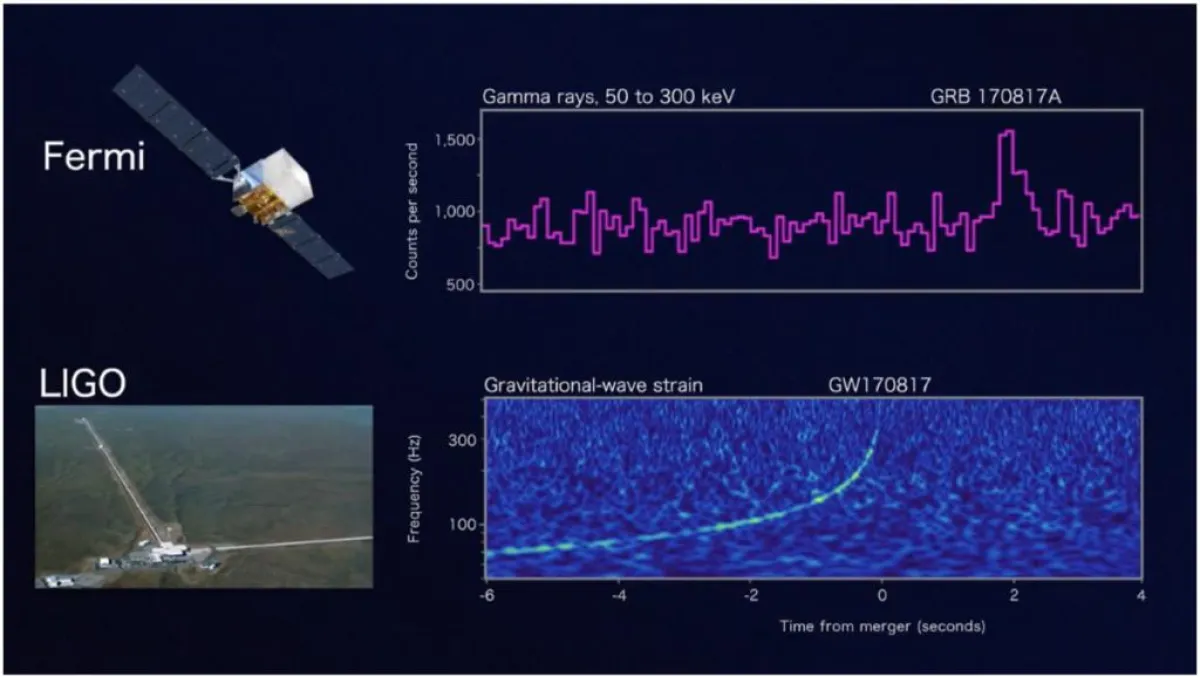Multi-messenger gravitational-wave astronomy
The first detection of the merger of two neutron stars – known as GW170817 – was a singular event in modern astronomy. The event was observed in gravitational waves and across the electromagnetic spectrum at gamma-ray, optical, infra-red, X-ray, and radio wavelengths. We are ready to follow up electromagnetic counterparts to future detections of gravitational waves and contribute to the new science of multi-messenger gravitational-wave astronomy.
Project status
Content navigation
About

FIG. 1: Coincident detection with gravitational waves and gamma rays. This animation reveals the LIGO and Fermi data synchronised to the merger time of the neutron stars. The gamma-ray burst occurred 1.7 seconds after the merger. The audio is the "chirp" sound of the gravitational wave signal, followed by a "ding" at the gamma-ray burst time. Credit: NASA GSFC & Caltech/MIT/LIGO Lab.
The first detection of the merger of two neutron stars – known as GW170817 – was a singular event in modern astronomy. The event was observed in gravitational waves [1] and across the electromagnetic spectrum [2] at gamma-ray, optical, infra-red, X-ray, and radio wavelengths. The information from these “multi-messenger” observations led to, among many other discoveries: the identification of the host galaxy of the neutron star merger; strong evidence linking neutron star mergers to so-called “short-hard” gamma-ray bursts; support for the theory that neutron star mergers are responsible for producing a significant fraction of the gold and other heavy elements in the Universe; limits on the speed of gravitational waves relative to the speed of light; and an independent measurement of the Hubble constant which governs the expansion of the Universe.
Video: CGA members Prof. Susan Scott and A/Prof. Christian Wolf discuss the detection of GW 170817.

FIG. 2: SkyMapper optical images of NGC 4993, the host galaxy containing GW170817, approximately 26 days before (left) and 1 day after (right) the detection of the event. Credit: Ref. [3].
The Centre for Gravitational Astrophysics (CGA) contributed to the detection of the gravitational wave event; parts of the computer code used to make the detection was written by CGA members as ANU Ph.D. students. A day after GW170817, the SkyMapper telescope located at ANU’s Siding Springs Observatory began observing the optical afterglow of GW170817 (Fig. 2). SkyMapper was the first telescope to report the temperature of the fireball following the event (visible in Fig. 2, right) which was much hotter than expected. The results of SkyMapper’s observations were reported alongside 13 other Australian telescopes and partner observatories in [3].
We are ready to follow up electromagnetic counterparts to future detections of gravitational waves and contribute to the new science of multi-messenger gravitational-wave astronomy. Alongside SkyMapper, a new infra-red telescope capable of rapid follow-up of gravitational wave events is being designed and built by ANU astronomers. Called DREAMS (Dynamic REd All-Sky Monitoring Survey), it will also be located at Siding Springs Observatory.
[3] Andreoni et al., Publ. Astron. Soc. Aust. 34, e069 (2017)
